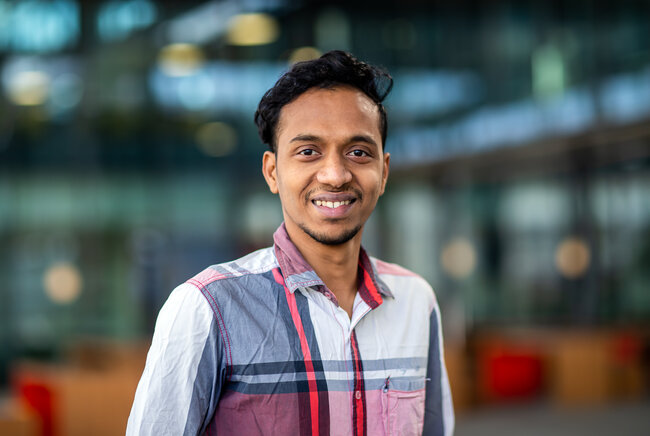Studying foreign body reaction in tissue due to implant failure
Phani Sudarsanam defended his PhD thesis at the Department of Biomedical Engineering on July 3rd.

Scientists have revolutionized biomedical implants like pacemakers, eye prostheses, and breast implants by developing tools to modify the properties of materials used to fabricate these devices. However, one of the biggest challenges faced by patients still is implant failure, which can be caused by a foreign body reaction. For his PhD research, Phani Sudarsanam explored strategies to combat this process in glaucoma drainage devices used to treat glaucoma patients.
Glaucoma is a disease caused by increased pressure in the outer part of the eye, resulting in damage to the optic nerve. Glaucoma ranks as the second most common cause of irreversible blindness worldwide, with estimates projecting over 100 million affected individuals aged between 40 and 80 by the year 2040.
Various devices are available on the market that drain the excess liquid responsible for the elevated pressure. However, these implants often fail due to a so-called foreign body reaction (FBR). This results in the formation of tissue around the devices and blocking the fluid drainage. Two key cell types that play a crucial role in FBR are macrophages and fibroblasts.
What do macrophages and fibroblasts do?
Macrophages – which are white blood cells present in the bloodstream and part of our immune system – are responsible for eliminating or consuming foreign bodies like microorganisms and dead cells.
After the implantation of a medical device in an individual, these cells respond to such medical devices by releasing various factors to degrade the device. These factors also recruit fibroblasts, another type of cell, which deposits tissue that wraps around the implants. The whole process is like a spider catching its prey with its web.
TopoChip
For his PhD research, Phani Sudarsanam focused on changing the cell behavior that leads to excessive tissue formation after implantation of glaucoma drainage devices (GDDs), thus leading to implant failure.
Sudarsanam tuned the surface properties of the implants by altering their topographical architecture. To achieve this, a platform called 'TopoChip' is utilized which has a library of 2,176 distinct shaped topographies. Studies were conducted using TopoChip with the above-mentioned two cell types, revealing that various topographies exhibit distinct cell responses including cell growth and cell attachment.
Based on different biological parameters that were analyzed, three topographies were chosen to fabricate the minimally invasive GDDs that were implanted in the eyes of rabbits to investigate the tissue formation after the implantation.
Sudarsanam observed differences in tissue composition between the implants with three topographies and all implants were seen to be functional after 30 days of implantation. However, further studies are required to comprehensively understand the implants' long-term effects and how tissue formation is modulated over extended periods, thus advancing toward clinical studies.
Interaction
In addition, Sudarsanam examined the interaction between macrophages and fibroblasts in another case study using breast implants. The aim of this study was to assess details of the interaction between the two cell types in the implant environment.
By growing macrophages on textured breast implants, Sudarsanam and his colleagues demonstrated that these implants led to the expression of distinct genetic signatures in the macrophages and influenced the shape of fibroblast cells in comparison to smooth breast implants. This study convincingly demonstrated the impact of implant texture on cell behavior.
Sudarsanam’s thesis represents a significant contribution to the field of biomaterials and implantology, addressing critical issues related to implant failure and tissue encapsulation. Through a comprehensive investigation, he has explored the role of biomaterial properties, particularly topographical architecture, in modulating cellular responses and improving the performance of medical implants.
Title of PhD thesis: Engineering topography mediated tissue response in foreign body reaction. Supervisors: Jan de Boer and Patricia Dankers.